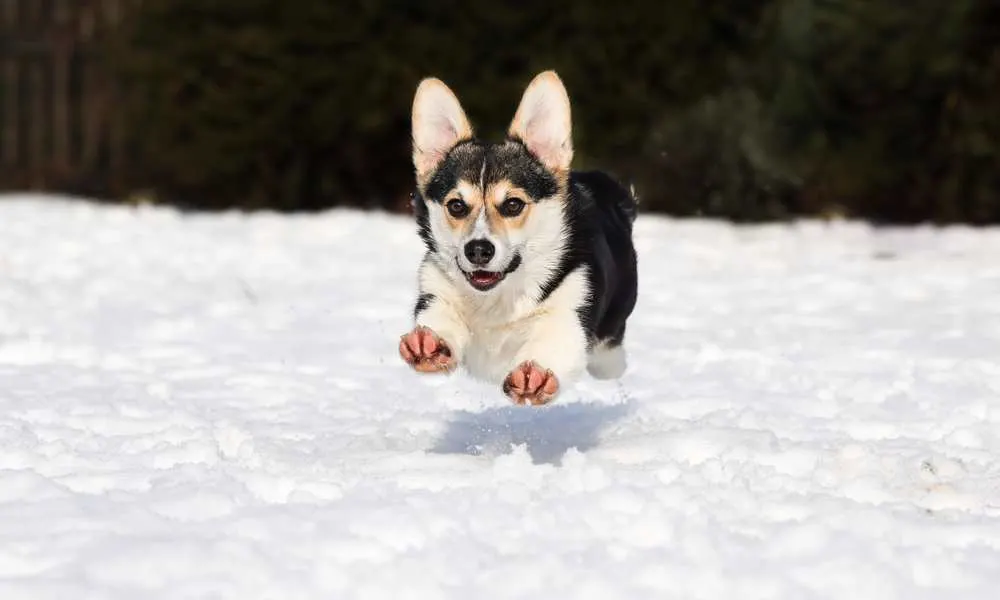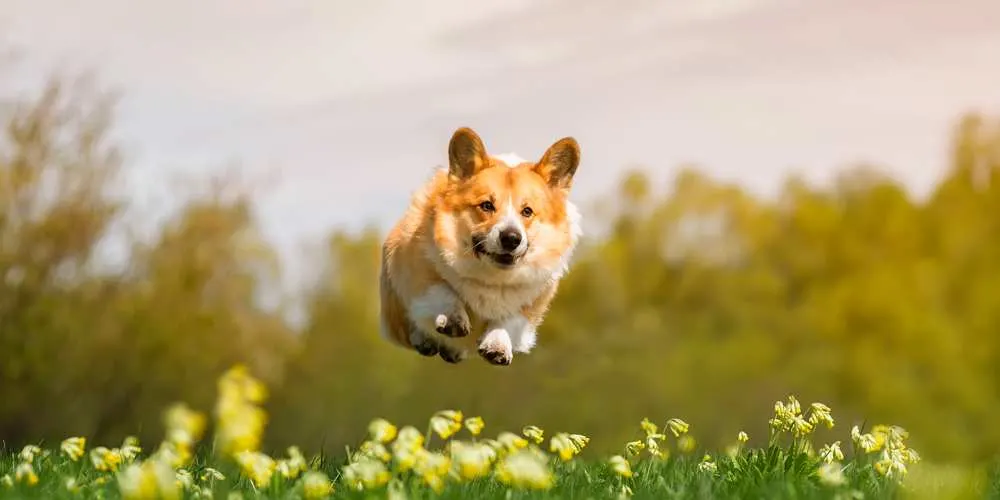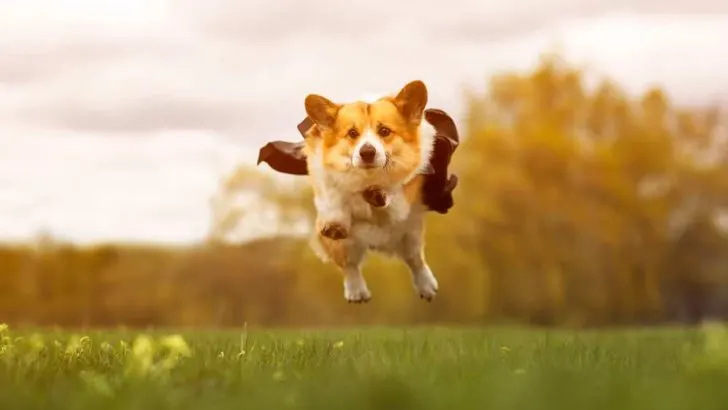If you haven’t seen your own corgi jumping around, you’ve probably seen some footage online of corgi owners filming their pets jumping around and having lots of fun. I know I’ve asked myself once or twice why does my corgi jump around, so I set on a mission to find out!
The answer to this dilemma is probably much more simple than you’d think – because they like it!
Well, although the general answer is simple, there are things that you should know about your corgi’s jumping habits such as: when should they start jumping, is it good for their back, or how high can they jump without injuring themselves.
All of these are not trivial and should be things you educate yourself on because there are some serious consequences if you don’t take care of your corgi’s feet and legs after a session of jumping and running around.
To find out all about these and to learn a thing or two about helping your corgi be fit and athletic by jumping around I highly suggest you keep reading and take notes just to be sure you got everything right!
Let’s go!

When Should My Corgi Start Jumping?
We should start from the basics. Many people (even corgi owners) don’t know that their dogs have a specific kind of dwarfism that makes your corgi’s legs so short and cute. This can sound intimidating, but I assure you every single corgi has it in its DNA.
This is actually desirable and should not pose any threats to your pet’s overall health. Corgis are used to living with shorter legs and they don’t have a problem using them as well as other dogs – and maybe even better!
But, this condition is something that should be taken into consideration because it can pose some problems in the early stages of your corgi’s life, especially when we talk about constantly jumping around.
It’s usually recommended that your corgi celebrates its first birthday before you let it jump around without any care in the world. This is just to be sure that their legs have fully developed to withstand the force with which these dogs usually jump around.
Corgis aren’t considered a big dog breed, but they aren’t exactly small like some others. A fully grown male corgi can have up to 14 kilograms and females are not noticeably smaller standing at a maximum of 13 kilograms when fully grown.
Now, imagine that weight jumping around on those small legs – it probably can’t be quite healthy. But, ironically enough, this only goes for the baby corgis, and not for fully grown ones.
One thing you need to pay attention to when we’re talking about fully grown corgis is that you shouldn’t let your pet jump around if they have some extra pounds on them because it can damage the joints.
When corgis start being hyperactive, zooming, running, and jumping it’s usually recommended to keep them under control until the first year of their life has passed just to be sure that the bones in their legs have fully grown and become as strong as possible.
This is the exact moment where jumping becomes completely fine and safe. There are scenarios where corgi owners have noticed that their pets experience some pain in their legs after a high-intensity jumping session.
If you do notice this in your one-year-old corgi puppy, you should probably wait for another couple of months just to be sure that their bones and joints have developed to their fullest potential.
When Should I Let My Corgi Puppy Jump?
There are situations where it’s completely fine for you to let and even encourage your corgi puppy to jump.
It’s easier if I tell you when not to let them jump and then if the situation is not listed here, it’s completely fine to play around with your pup and let them jump for a few minutes.
The situations where you shouldn’t let your corgi puppy jump are:
- Early on in the morning right after they wake up – they’re sleepy and their coordination is not yet on a good enough level so there’s a possibility of them injuring themselves while jumping at that time.
- Off of high surfaces – all dogs have a tendency to jump from a sofa, a couch, or a stool. This isn’t recommended as it can put overwhelming pressure on their hips.
- If they are overweight – if your puppy has some extra pounds you should be patient for a little longer or stimulate them to lose the extra weight before jumping just to preserve their joints.
So if the situation is not one of these three, it’s completely fine to let your corgi jump around. I recommend they jump on the surface level and on an open field because the grassy dirt can be better for their joints than concrete or wooden floors.

Jumping Around – What’s The Reason?
Now that we have covered the basics, it’s time to dive deep into the reasoning behind this. Unfortunately, this occurrence doesn’t have a magical story behind it like the story of the fairy saddle, but there are some speculations why corgis jump around much more than the other dog breeds.
The reason I’m talking about is laying in their short legs. Dogs usually run and that’s because they have long and strong legs to support them and get them where they need to be in seconds.
But, the corgis are a different story. Because of the dwarfism I mentioned earlier, corgis aren’t really used to running all that much. This is quite interesting because of the fact that they’ve been designed to be a herding dog which requires quite a lot of running around.
With years of experience, corgis have developed a liking towards jumping because it can get them further than the plain old regular running.
They have been doing it for so long that it has earned a place in their DNA quite a long ago, so there is a good possibility that your corgi will start jumping without ever seeing another corgi do that in front of them.
This is only an indicator of how naturally it comes to them. Keep that in mind when you see your corgi jumping because if you let it jump for a while before it should, it will be a pretty hard job of making them stop.
Read Also: Why Do Corgis Run In Circles?

What Can Go Wrong?
There are some unwanted consequences of your corgi jumping around in some situations. These are quite rare but that isn’t a reason for you not to inform yourself about them.
For example, you never know if your corgi is likely to develop hip dysplasia and when you let them jump around it can quicken the process of the disease developing.
That is why you always have to have your dog insight when they’re jumping just to make sure that you see if they are jumping or landing funny or if they limp after a jump or two.
Like hip dysplasia, there are some other potential circumstances that you need to be aware of. I will now list one of the most common ones just to be sure you’ve been warned:
- Hip dysplasia – it’s the most common disease among all dogs (including corgis) so you have to pay attention to your dog’s back legs after intensive play sessions where your dog have jumped a lot.
- Elbow dysplasia – it’s quite similar to hip dysplasia but you can easily tell them apart because it can often happen in the front legs and your dog won’t have problems while trying to sit unlike with hip dysplasia.
- Paw fractures – if your corgi sticks to a bad landing it can also take a toll on their paws breaking one of the fine bones in their paws. You’ll probably notice this right away as they won’t be able to put any weight on that paw.
It goes without saying that if you notice any of these you should take your corgi to their vet right away, as these injuries can get worse over time and won’t resolve by themselves.
Learn More: Can Corgis Jump High? How High Can Corgis Jump?

Final Thoughts
Now that you have learned all there is about your pet jumping and when to let them start doing that, it’s just a matter of time and place where your puppy will start doing that.
If you have a fully grown corgi you have probably seen it jump around with a happy smile on its face. If you don’t notice any consequences to jumping it’s totally fine to grab your camera and snap a couple of photos of them doing this!
So, just remember the situations where you shouldn’t let your corgi jump and remember that if you see any evident injury or when you’re just suspicious your corgi suffered one, you should call the vet immediately.
After all of this reading, the only thing that is left to do is to grab your corgi’s favorite leash and find an open field when your corgi can start jumping and zooming.
Have fun!

